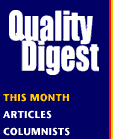|
|
|
|
Today's Specials |
|
|
|
|
Six Sigma and Beyond |

The Six Sigma Management Paradox Creative breakthroughs occur only when we have the freedom to try new things. |
Simply stated, the six sigma management paradox is as follows: To attain six sigma performance, we must minimize process variability, slack and redundancy by building variability, slack and redundancy into our organizations. Six sigma involves an intense effort to reduce process variation to a minimum so that processes consistently meet or exceed customer expectations and requirements. However, revolutionary improvement rates and quality levels can only be achieved by breakthroughs in thinking. These creative breakthroughs can occur only if the organization allows teams and individuals the freedom to try many new things. Whenever something new is tried, there is a risk of failure, which increases waste in the short term. The best minds will be drawn to creative activities (and away from their usual duties) as moths are drawn to light. The organization must possess sufficient slack--i.e., extra resources--to ensure that critical functions continue despite the absence of these key personnel. Leaders must be vigilant to ensure that the paradox is understood. When one learns a new principle, there is a tendency (especially in the beginning) to go overboard in applying it. A fundamental principle of six sigma is reduction of variability. The tendency is to apply this principle to everything . Advocates examine every process with an eye toward bringing it under control; that is, making the process efficient, capable and predictable. In the early stages, the payoffs from these activities are often huge because the organization is awash in wasted resources and nonproductive or counterproductive activity (i.e., redundancy and slack). However, as progress continues, there is less and less unplanned slack in the organization. If care isn't taken, six sigma can ultimately result in an organization that is unable to grow and adapt to a changing environment. The common form of many modern organizations is what I call "hard wired." The organization chart is the blueprint, and the policy-and-procedure manuals are the operating instructions for this machine. As with a circuit board, the idea is that certain outputs (products, services, profits) will be produced when certain inputs (money, people, ideas) are provided. Such organizations are highly efficient; resources are carefully managed to avoid waste. However, they are also very inflexible and difficult to change. These organizations tend to rely heavily on formal mechanisms, such as chartered teams, to create change. Senior management forces the various functions to provide resources (people, facilities, etc.) to the teams, in effect tapping into the main resource circuits to draw off energy for change. Maintaining the momentum for change in these organizations requires the vigilance of top management because the "true" resource owners--the managers of the functions whose resources are being appropriated--are constantly trying to stop the energy drain from their areas. Such organizations are constantly fighting "resistance to change." Six sigma tends to work poorly in hardwired organizations because it's difficult to get the required resources and the necessary permissions to conduct experiments and make process changes. A second type of organization is the "soft wired" organization. In a soft-wired organization, there are floating resources that are not fully under the control of a particular function. These resources can be easily reconfigured to perform a variety of different activities. 3M's tradition of allowing certain technical people to claim 15 percent of their time to pursue projects of their own choosing is an example of soft-wiring. The Brazilian company Semco has freelance engineers who report to no one and receive a share of the proceeds from any ideas and innovations they dream up. There are many other examples of soft-wiring, and they produce amazing results. The soft-wired organizational form is well-suited to the rapid but directed change six sigma requires. An emergent third type of organization, about which I write extensively in my book The End of Management, is the "spontaneous enterprise." Scientists call these organizations "complex adaptive systems." Such systems are all around us; examples include the rain forest, the brain and the free market. They are vastly more complex than any business firm, and also very orderly. Until recently, we could only marvel that these amazing systems could exist and function so beautifully without a leader or a plan. However, scientists have finally begun to discover the rules that govern such systems. With our new understanding, we can see how we might design more effective human organizations. They could depend on self-organization, rather than on a costly and ineffective system of rules and hierarchy (i.e., management), for order. At this time, there are only a few organizations of this type, such as the credit card behemoth VISA. However, as we learn from these pioneers, we should see more spontaneous enterprise organizations. Because six sigma is a management program, it would need to be radically modified to work in a spontaneous enterprise. One possibility is that six sigma technical leaders would play important supporting roles to leaders, providing them with information to help them maintain a competitive edge. Regardless of how we administer a six sigma program, its paradox will always apply--even to the most complex of organizations. About the author Thomas Pyzdek is the author of The Complete Guide to Six Sigma (available at www.qualityamerica.com ) and a consultant in performance improvement. Visit his Web site at www.pyzdek.com or e-mail him at Tom Pyzdek . |
Menu Level Above
This Menu LeveL
Menu Level Below
Copyright 1999 QCI International. All rights reserved.
Quality Digest can be reached by phone at (530) 893-4095. E-mail: Click Here


